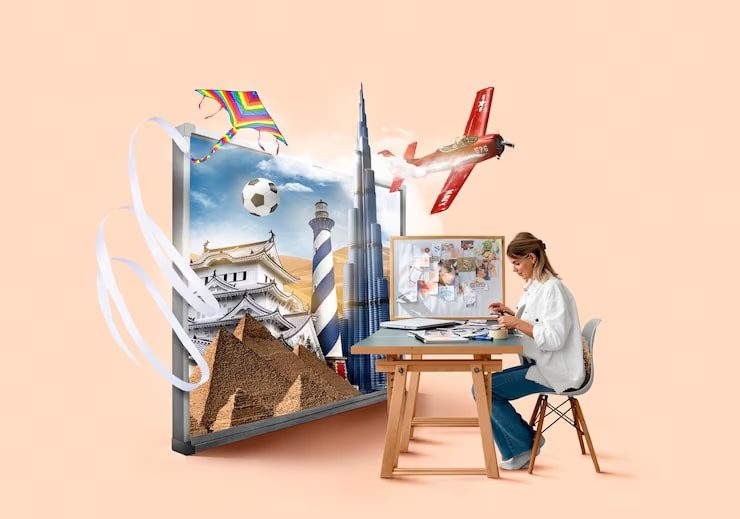In recent years, the fusion of tech in art has sparked a transformative shift, blending digital innovation with traditional creativity. Artists and technologists alike are pushing boundaries, opening doors to new mediums, and creating a dynamic landscape where art meets cutting-edge technology. The result? A brave new world where artistic expression evolves through the lens of digital advancements, redefining how we experience and appreciate art.
Let’s dive into how tech in art is changing the creative landscape and reshaping the future of artistic expression.
A Brief History of Tech in Art
While technology has always played a role in shaping art—think of the invention of photography or the printing press—today’s digital era is taking it to a whole new level. From virtual reality installations to AI-generated artworks, tech in art is pushing the envelope on what we consider art. In fact, according to a study by the Art Market 2023 report, digital art sales surged by 40% over the last two years, indicating a significant shift toward tech-driven creations.
Digital Art: A New Canvas for Artists
Digital art has grown from niche to mainstream, with artists now leveraging software like Photoshop, Procreate, and Blender to bring their visions to life. This new wave of artists uses pixels and code in place of paint and brushes, allowing for unprecedented levels of creativity and manipulation. Whether it’s creating surreal landscapes or intricate portraits, digital platforms enable artists to work faster, explore new styles, and share their art with a global audience.
One of the prime examples of tech in art is the rise of NFTs (non-fungible tokens). NFTs have revolutionized how digital art is valued, owned, and distributed. In 2021, digital artist Beeple made headlines by selling an NFT for $69 million, highlighting the power of technology in reshaping the art market. It’s a clear signal that tech in art is here to stay, and it’s changing the rules of the game.
Tech and Traditional Art Forms
It’s not just digital artists who are embracing technology. Traditional artists are incorporating tech in art to enhance their work. Take projection mapping, for instance—this technology allows artists to transform entire buildings into moving works of art. One such example is the 2019 “Refik Anadol: Infinite Space” installation at ARTECHOUSE in Washington, D.C., which used data visualization, AI, and projection to immerse viewers in a stunning visual experience.
The Role of AI in Art
One of the most fascinating developments in tech in art is the use of artificial intelligence (AI). AI-generated art is on the rise, with algorithms being trained to create everything from paintings to music. This kind of artwork challenges our understanding of creativity—can a machine truly create art, or is it simply mimicking human processes?
The AI artist known as “AI-Da” has taken the art world by storm. This humanoid robot uses algorithms to analyze visual inputs and generate its own original artwork. What makes this phenomenon even more intriguing is the philosophical debate it stirs: Who owns the art—the machine, its programmers, or the viewers who interpret it?
Virtual and Augmented Reality: Immersive Art Experiences
Virtual reality (VR) and augmented reality (AR) are further pushing the envelope of tech in art by offering immersive experiences. In these environments, art isn’t just something you look at—it’s something you step into. Museums and galleries are adopting VR and AR technologies to create interactive exhibitions, allowing viewers to experience art in new and engaging ways.
Table: Key Technologies Transforming the Art World
| Technology | Use in Art | Example |
| AI | AI-generated art, music, and design | AI-Da, Google’s DeepDream |
| 3D Printing | Sculptures, prototypes | Digital sculptures by Anouk Wipprecht |
| NFTs | Digital ownership, collectibles | Beeple’s $69M NFT sale |
| Virtual Reality (VR) | Immersive experiences | “The Night Café” VR installation |
| Projection Mapping | Visual installations | Refik Anadol’s “Infinite Space” |
The Future of Tech in Art
Looking ahead, it’s clear that tech in art will continue to evolve and challenge traditional definitions of creativity. AI, VR, and NFTs are just the beginning—who knows what the next decade will bring? One thing is certain: the convergence of art and technology is opening doors to innovation, accessibility, and collaboration on a global scale.
Conclusion
The marriage of tech in art is not just a fleeting trend; it’s a revolution that is reshaping the way we create, experience, and value art. From AI-generated masterpieces to immersive VR exhibits, the possibilities are endless, and the future of art is undoubtedly digital. As artists continue to push boundaries with technology, we are witnessing a new era where creativity knows no limits.







